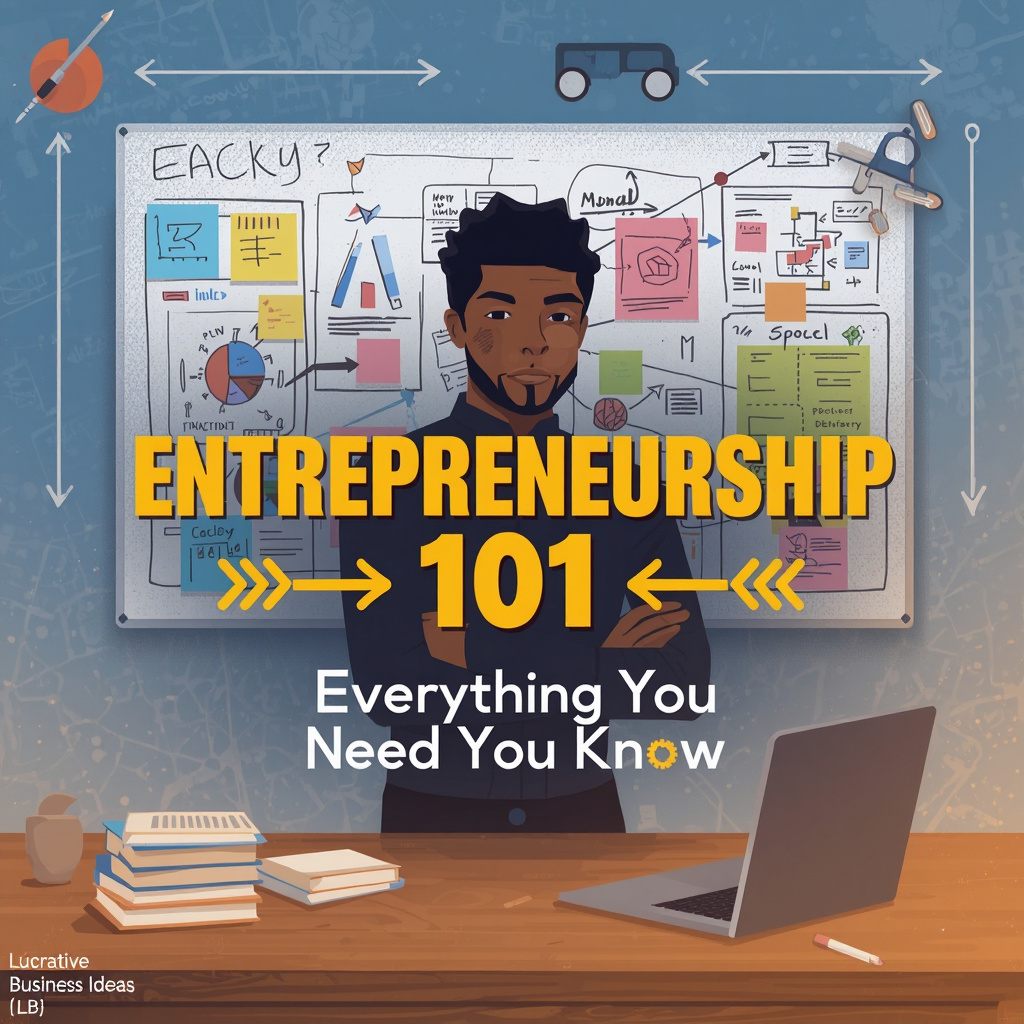I’ll explain this in the voice of a seasoned tutor and business consultant/analyst (think: what you’d hear from someone with decades of practical experience). I won’t sugarcoat it: entrepreneurship is thrilling and brutal at the same time. Here’s a clear, actionable, persuasive guide to what entrepreneurship is, what it takes to succeed, the advantages and challenges, the main types, and an immediate roadmap you can use today.

What is Entrepreneurship?
Entrepreneurship is the practice of identifying problems that needs and building sustainable solutions that create value for customers and capture value for the founder(s). At its heart it’s three things:
- Problem + Customer Focus — spotting a real problem someone will pay to solve.
- Value Creation — designing a product, service, or business model that solves that problem.
- Value Capture — turning the solution into a repeatable, scalable way to earn revenue or social impact.
Entrepreneurship is not only about ideas — it’s about testing, selling, and learning faster than your competitors.
What it Takes to Become a Successful Entrepreneur
Success comes from combining the right mindset, skills, and systems. Below are the core elements and how to start building them now.
1. Mindset (the foundation)
- Relentless Curiosity — ask “why” and “why not” about everything.
- Growth Orientation — treat failures as experiments and data.
- Resilience & Patience — you will face setbacks; persistence matters more than genius.
- Bias to Action — ideas are worthless until you test them in the real world.
2. Skills You Must Develop
- Customer Discovery & Sales — can you sell the problem/solution to real people? (This beats fancy designs.)
- Product Sense / MVP Building — how to build the smallest thing that proves value.
- Basic Finance — margins, cash flow, burn rate, runway. Know your numbers.
- Marketing & Positioning — how to reach and persuade your first customers.
- Operations & Hiring — processes and people scale a business.
- Decision-making under Uncertainty — decide with incomplete info and learn fast.
3. Habits & Disciplines
- Do at least one high-leverage activity daily (talk to customers, sell, ship).
- Keep a 90-day plan and measure weekly progress.
- Log assumptions and tests: “If X then Y” — test them quickly and cheaply.
- Build an accountability loop: mentor, cofounder, or small advisory group.
4. Practical Playbook (step-by-step)
- Idea → Problem fit: Pick a problem you can explain in one sentence.
- Customer Discovery: Do 30–100 interviews. Stop when patterns repeat.
- MVP: Build the minimum that solves the core problem (landing page, manual service, simple product).
- Sell before you scale: Get paying customers or strong pre-orders.
- Measure unit economics: CAC (customer acquisition cost) vs LTV (customer lifetime value).
- Iterate or pivot: Use real customer feedback to improve.
- Scale responsibly: hire, systemize, and invest in marketing that shows ROAS.
Advantages of Entrepreneurship (why it’s worth it)
- Autonomy & Control — you call strategic shots.
- Unlimited Upside — earnings are linked to the business, not a salary cap.
- Fast Learning — you’ll learn ten years of business in a couple of intense years.
- Impact & Legacy — create jobs, help people, change industries.
- Flexible Life Design — design your work around your life goals (if you want that).
Challenges of Entrepreneurship (and how to manage them)
Entrepreneurship adds risk and stress. Here’s what commonly trips founders up — and practical ways to mitigate each.
- Uncertain Income & Cash Flow. Mitigation: Start with part-time experiments, keep a personal runway (6–12 months where possible), and prioritize early revenue.
- Finding Product-Market Fit (PMF). Mitigation: Do deep customer interviews. Build and measure a simple MVP. PMF is proven by repeat purchases and referrals.
- Burnout & Workload. Mitigation: Set realistic sprints, delegate early, and treat rest as productivity. Build rituals (sleep, exercise, weekly planning).
- Funding & Dilution Pressures. Mitigation: Choose funding that matches goals — bootstrap if you want control, raise capital if you need rapid scale and can show traction.
- Team & Hiring Mistakes. Mitigation: Hire for attitude and problem-solving. Start with contractors/freelancers to validate roles before full-time hires.
- Legal, Compliance, and Taxes. Mitigation: Get basic legal templates (contracts, terms), a simple accounting system, and consult a pro for complex issues.
- Competition & Market Shifts. Mitigation: Focus on defensible advantages (customer relationships, speed to learn, specialized knowledge).
- Scaling Mistakes. Mitigation: Systemize processes before doubling headcount. Scale marketing only when unit economics work.
Types of Entrepreneurship (short taxonomy with examples)
You’ll choose a path based on ambition, risk tolerance, and lifestyle.
- Small-Business Entrepreneurship — local shops, services, restaurants. Example: a neighborhood café. (Stable; community-focused.)
- Scalable Startup Entrepreneurship — builds for fast growth and external capital (tech startups). Example: SaaS app with VC funding. (High risk, high reward.)
- Lifestyle Entrepreneurship — businesses created to support a preferred lifestyle. Example: freelance design studio, e-commerce store. (Freedom-focused.)
- Social Entrepreneurship — mission-driven ventures prioritizing impact (nonprofits or hybrid). Example: an NGO employing locals to recycle waste.
- Franchise Entrepreneurship — buy a proven business model (fast-food franchise). (Lower idea risk; higher capital cost.)
- Corporate / Intrapreneurship — innovate within a large company. (Leverage resources; limited ownership.)
- E-commerce & Digital Entrepreneurship — online stores, info products, apps. (Low overhead; global reach.)
- Solopreneur / Gig Economy — single-person businesses (consulting, coaching). (Fast to start; limited scale unless systemized.)
Which is Best?
- If you want fast scale and big exits — aim for scalable startups.
- If you want controlled risk and predictable cash — start small/bootstrapped or lifestyle businesses. Both are valid.
Metrics You Must Understand (simple definitions)
- Runway — months your business can operate before cash runs out.
- CAC (Customer Acquisition Cost) — how much you spend to acquire a customer.
- LTV (Lifetime Value) — revenue expected from a customer over time.
- Conversion rate — % of prospects who become customers.
- Gross Margin — revenue left after direct costs.
- Track these Weekly or Monthly — they tell whether growth is healthy or dangerous.
Common Mistakes to Avoid as an Entrepreneur
- Building features people don’t want.
- Hiring too fast.
- Ignoring sales (product without customers).
- Raising money before proving demand.
- Trying to be perfect instead of shipping imperfectly and improving.
A Result-Driven 90-Day Plan (do this now):
Day 0 — Commitment: pick one problem you want to solve and commit 90 days.
First 30 Days (learn & validate):
- Do 30 customer interviews.
- Create a one-page idea summary (problem, solution, customer, why now).
- Build a simple landing page or manual service offer.
Next 30 Days (sell & measure):
- Run small experiments (ads, posts, direct outreach).
- Get your first 5 paying customers or 50 signups.
- Calculate CAC and one basic unit economics number.
Last 30 Days (iterate & plan to scale):
- Improve the product based on feedback.
- Create a 6-month plan with milestones (revenue targets, hires, tech).
- Apply to one accelerator or pitch to two potential early investors/customers if you need capital.
Final, Persuasive Reality Check
Becoming a successful entrepreneur is a marathon of experiments, not a lightning strike. You’ll win by being the smartest learner in the room: test fast, sell first, measure every decision, and protect your time and energy. The world rewards those who produce value reliably and repeatedly.
Immediate next steps (do these in the next 48 hours)
- Write one sentence: the problem you want to solve and who has it.
- Schedule 10 short customer interviews (message people on social or call neighbors).
- Build a one-page landing page or Google Form offering a solution and collect emails.
See Also:

